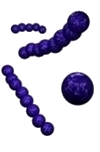 |
 |
Streptococcus anginosus |
This image depicts a Petri dish filled with trypticase soy agar medium containing 5% defibrinated sheep's blood. After having been inoculated with alpha-hemolytic Streptococcus anginosus bacteria, i.e., a member of the Gram-positive viridans group of streptococci, the BAP was incubated in a carbon dioxide enriched atmosphere at 35oC for 24 hours. The culture grew numbers of surface bacterial colonies. The characteristic color changes, i.e., a hazy, faded, indistinct region surrounding each colony in which some of the red blood cells (RBCs) were destroyed in the blood agar medium, or "hemolyzed", indicated that these bacteria were indeed alpha-hemolytic in nature.
It is the incomplete nature of the hemolytic reaction adjacent to the colonies, which spares numbers of RBCs in the blood agar medium, that is of qualitative importance when distinguishing alpha from beta-hemolysis.
Bacteria in the viridans group of Streptococci are, for the most part, non-pathogenic, which means that they usually do not cause respiratory disease. In fact, these bacteria are normally found in the nose and throat of human beings. When an organism lives on, or inside another organism, thereby, deriving benefits from the relationship without causing harm to the host, it is known as "commensalism". It is when ones immunity is compromised that these normally harmless bacteria can become pathogenic, as in the case of HIV/AIDS, or immunosuppressed individuals undergoing chemotherapy.
|
| |
|